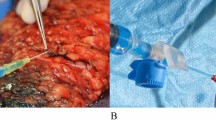Summary
To demonstrate differences in the permeability of capillaries in certain areas of the rabbit, the lymph of the following regions was collected: the hind legs, kidney, liver, and of the thoracic duct, which is the lymph drainage for the whole backside of the animal. The animals recieved a constant infusion of polyvinylpyrrolidone (PVP) of a molecular weight of 38000, and the plasma and lymph concentrations of PVP, of total protein and of the fractions albumin, α1-, α2-, β- and γ-globulin and fibrinogen were determined.
The lymph/plasma ratios of PVP were: hind legs 0,3; thoracic duct 0.35; kidney 0.7; liver 0.8.
The lymph/plasma ratios of total protein were 0.7 for the hind legs; 0.7 for the thoracic duct; 0.8 for the kidney; 0.9 for the liver. Compared with the plasma, the albumin/globulin ratio in all lymph types has shifted in favour of the albumin. A decrease of the protein concentrations in the lymph following an increase in molecular weight was expected but could not be seen; all protein fractions in the lymph were, compared with the plasma, diminished to about the same amount.
From these experiments, it can be seen that the permeability of capillaries differs in certain areas. The capillary permeability of the kidney and of the liver is high in the experiments with PVP; the capillary permeability in the legs and in those capillaries reached by canulating the thoracic duct is low.
PVP seems to penetrate in a different way from the plasma into the lymph than endogenous protein of a much higher molecular weight. Therefore only the use of exogenous compounds like PVP, Dextrane, J131-albumin may give informations about capillary permeability; only under such experimental conditions a relation between molecular weight and penetration through the capillary membrane can be seen.
Zusammenfassung
Zur Bestimmung möglicher regionaler Unterschiede der Capillarpermeabilität von Kaninchen wurde Lymphe der folgenden Regionen gewonnen: hintere Extremitäten, Niere, Leber und solche aus dem Ductus thoracicus als „Sammellymphe“ der hinteren Tierhälfte. Die Tiere erhielten eine Dauerinfusion von Polyvinylpyrrolidon (PVP), MG 38000; in den genannten Lymphen und im Plasma wurden die Konzentrationen an PVP, Gesamtprotein und den Proteinfraktionen: Albumin, α1-, α2-, β- und γ-Globulin sowie Fibrinogen gemessen.
Die PVP-Konzentrationsquotienten Lymphe/Plasma sind: hintere Extremität 0,3; Ductus thoracicus 0,35; Niere 0,7; Leber 0,8.
Die Konzentrationsquotienten Lymphe/Plasma für Gesamtprotein betragen: hintere Extremität 0,7; Ductus thoracicus 0,7; Niere 0,8; Leber 0,9. Der Albumin/Globulin-Quotient ist gegenüber dem Plasma in allen Lymphen zugunsten des Albumins verschoben. Der erwartete Befund, daß die Lymphkonzentrationen der Proteine mit steigendem Molekulargewicht abnehmen, wurde nicht erhoben, vielmehr waren alle Proteinfraktionen in der Lymphe gegenüber dem Plasma annähernd gleich vermindert.
Die Ergebnisse zeigen, daß die Capillarpermeabilität erhebliche regionale Differenzen aufweist. Nach den PVP-Versuchen ist die Permeabilität der Nieren- und Lebercapillaren groß, die der Beincapillaren und jener, die bei Kanulierung des Ductus thoracicus erfaßt werden, gering.
Die Fremdsubstanz PVP zeigt bezüglich des Übertrittes aus dem Plasma in die Lymphe ein deutlich anderes Verhalten als endogene Proteine eines erheblich größeren Molekulargewichtes. Somit besteht zwischen dem Molekulargewicht und der Penetration durch die Capillarmembran nur dann eine Beziehung, die Rückschlüsse auf die Capillarpermeabilität gestattet, wenn als Prüfsubstanzen exogene Stoffe eingesetzt werden, z. B. PVP, Dextran oder J131-Albumin.
Similar content being viewed by others
Literatur
Antweiler, H. J.: Zur Methode der quantitativen Elektrophorese, in Antweiler: Die quantitative Elektrophorese in der Medizin. 2. Aufl., S. 1. Berlin, Göttingen, Heidelberg: Springer 1957.
Areskog, N.-H., G. Arturson, and G. Grotte: Heart lymph: electrolyte composition and changes induced by cardiac glycosides. Biochem. Pharmacol. 14, 783 (1965).
Chien, S., D. G. Sinclair, C. Chang, B. Peric, and R. J. Dellenback: Simultaneous study of capillary permeability to several macromolecules. Amer. J. Physiol. 207, 513 (1964).
Courtice, F. C., G. Woolley, and D. G. Garlick: The transference of macromolecules from plasma to lymph in the liver. Aust. J. exp. Biol. med. Sci. 40, 111 (1962).
Grotte, G.: Passage of dextran molecules across the blood-lymph barrier. Acta chir. scand. Suppl. 211 (1956).
Levy, G. B., and D. Fergus: Microdetermination of polyvinylpyrrolidone in aqueous solution and in body fluids. Analyt. Chem. 25, 1408 (1953).
Mayerson, H. S.: Observations and reflections on the lymphatic system. Trans. Stud. Coll. Phycns Philad. 28, 109 (1961).
— C. G. Wolfram, H. H. Shirley jr., and K. Wasserman: Regional differences in capillary permeability. Amer. J. Physiol. 198, 155 (1960).
Miller, A. J., A. Ellis, and L. N. Katz: Cardiac lymph: flow rates and composition in dogs. Amer. J. Physiol. 206, 63 (1964).
Scholtan, W.: Beziehung zwischen der Größe von Polyvinylpyrrolidon-Molekülen und ihrer Permeabilität durch die Glomerulummembranen der Niere. Z. ges. exp. Med. 130, 556 (1959).
Vogel, G., u. I. Stoeckert: Daten zu Lymphfluß und-druck im Ductus thoracicus der Ratte und der Zusammensetzung von Lymphe und Plasma. Pflügers Arch. ges. Physiol. 277, 236 (1963).
—, u. H. Ströcker: Die Penetration von Polyvinylpyrrolidon durch die Plasma-Lymph-Schranke bei Ratten. Eine Methode zur Beurteilung der Capillarpermeabilität. Pflügers Arch. ges. Physiol. 279, 187 (1964).
— Die Wirkung von Pharmaka — insbesondere von Flavonoiden und Aescin — auf den Lymphfluß und die Permeabilität der intakten Plasma-Lymph-Schranke von Ratten für Flüssigkeit und definierte Makromoleküle. Arzneimittel-Forsch. 16, 1630 (1966).
-- B. Wendt u. H. Ströcker: Versuche zur Wirkung von Pharmaka auf die Plasma-Lymph-Schranke von Ratten nach Einstellen eines Zustandes gesteigerter Kapillarpermeabilität. Arzneimittel-Forsch. (im Druck).
Yoffey, J. M., and F. C. Courtice: Lymphatics, lymph and lymphoid tissue. London: E. Arnold Ltd. 1956.
Author information
Authors and Affiliations
Rights and permissions
About this article
Cite this article
Vogel, G., Ströcker, H. Regionale Unterschiede der Capillarpermeabilität. Pflügers Archiv 294, 119–126 (1967). https://doi.org/10.1007/BF00363601
Received:
Issue Date:
DOI: https://doi.org/10.1007/BF00363601




